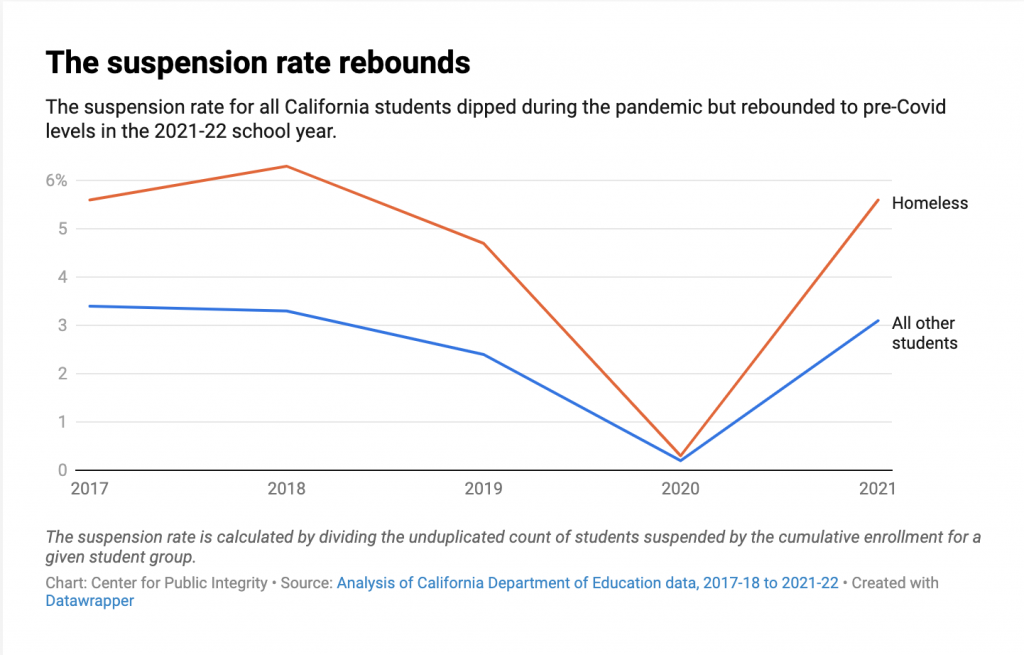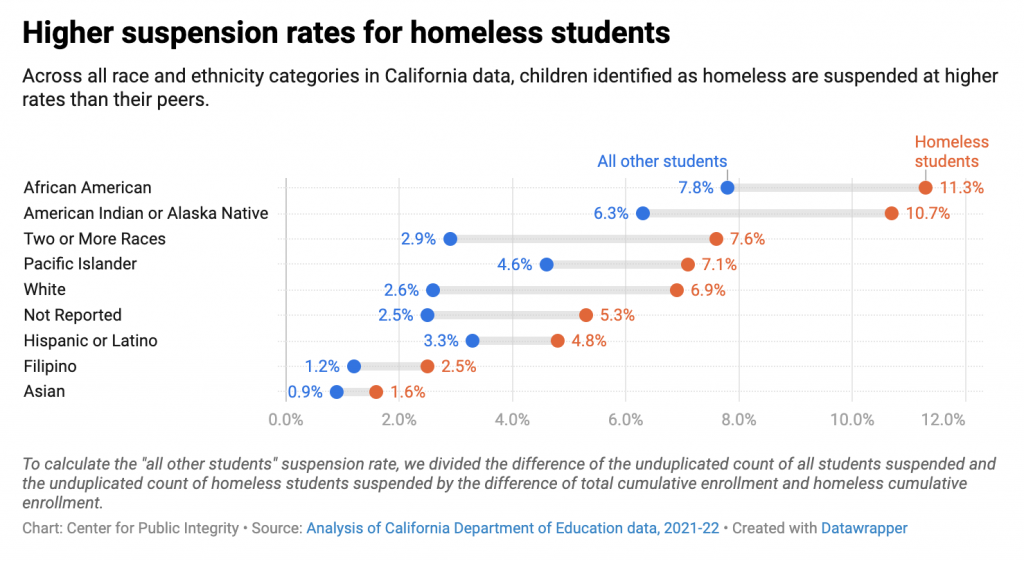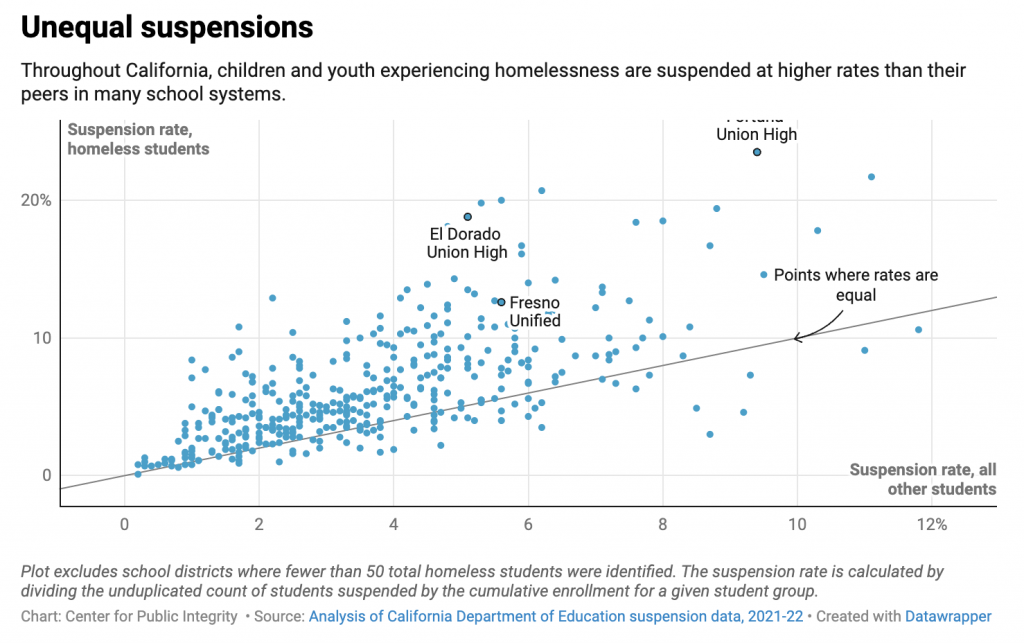By Amy DiPierro, The Center for Public Integrity
Federal education law explicitly seeks to help homeless children and youth stay in school, in the hopes academic opportunity will allow them to break the cycle of housing instability.
Taking them out of class could worsen their chances of success.
But an analysis of data in California shows the state’s homeless students are suspended at higher rates than their peers.
California schools suspended more than 12,000 students who were identified as homeless in the 2021-2022 school year, according to a Center for Public Integrity analysis of the most recent data available. That means nearly 6% of all homeless students were suspended compared to roughly 3% of all other students.
And in about 20% of school districts across the state, homeless students were suspended at rates at least double the district baseline in recent school years — in some cases, far higher. The disparity persisted in some districts as overall suspension rates rebounded after school closures earlier in the pandemic.
The McKinney-Vento Homeless Assistance Act — the federal law promising equal access to education for homeless students — requires schools to remove obstacles to those students’ education, whether by arranging transportation to school or waiving normally required paperwork.
There’s no ban on suspensions — but they’re hardly in keeping with the spirit of the law.
“The whole point of the McKinney-Vento Act was to ensure that students that are experiencing homelessness are in school,” said Lynda Thistle Elliott, a former state homeless education coordinator in New Hampshire. “It’s really important to look at in what instances do we actually remove students from school, which is the one thing they really, really need to make a difference.”

And the figures in California may only scratch the surface, since many homeless youth aren’t identified as such by their school system and struggle without federally required help.
Earl Edwards, an assistant professor at Boston College, said that when he interviewed students experiencing homelessness, he found that the threat of school discipline often discouraged them from telling teachers or other staff about their housing status.
“They would say, ‘I didn’t tell the school anything about what was going on, because every time I got to school, they was yelling at me for being late,’” he said. “[Discipline] actually deteriorates the trust that those kids have, when they’re being punished, a lot of times, for being impoverished.”
California educators said their school systems have already implemented disciplinary reforms that emphasize reconciling students with their classmates and teachers while preventing behaviors that could result in punishment. Still, many noted that nothing in state law mandates school officials to adjust how or whether to discipline a student based on their homeless status.
“There’s no requirement for educators currently to, per se, consider housing,” said Jennifer Kottke, who helps to train districts on homeless education law through the Los Angeles County Office of Education. But she added that educators ought to consult colleagues who work with homeless youth to weigh “what’s happening in the lives of the students” when deciding how to respond to behavior.
The U.S. Department of Education’s Office for Civil Rights, which tracks school discipline data nationwide, does not break it out by housing status.
But California, which has the third-highest rate of student homelessness in the country, is not the only state where available data suggests children and youth without stable housing are more likely to experience discipline, too.
Students experiencing homelessness in Washington were suspended and expelled at almost three times the rate of their housed peers, The Seattle Times reported in a 2022 article produced as part of a collaboration between the Center for Public Integrity and the Times, Street Sense Media and WAMU/DCist. And studies in Florida, Indiana, Michigan, New York, Texas and Washington found similar results.
Homeless students, high stakes suspension
A student who qualifies under the U.S. Department of Education’s definition of homelessness — which includes children forced to share housing because they lost their own — may be suspended more frequently than their stably housed peers for a number of reasons.
Homeless students may change schools, disrupting opportunities to build meaningful relationships with adults or fellow students. They may miss school days, causing them to fall behind academically and socially. They may experience other trauma related to losing their housing, whether it be a sudden eviction or domestic violence.
Racial discrimination could also play a role. African American students in California are disproportionately suspended from schools — and are overrepresented among homeless students, too.
Accessibility is another potential factor. Students receiving services under the Individuals with Disabilities Education Act are both more likely to receive a suspension than peers and are more likely to experience homelessness.

As a result of those disparities, guidance under California law encourages educators to consider students’ disabilities before disciplining them.
Educators interviewed for this story said they cannot divert a homeless child to an alternative other than a suspension where the law requires one.
Still, nothing prevents schools from examining the broader picture of students’ lives in situations where suspension is not mandatory. Cynthia Rice, legal director at the Civil Rights Education and Enforcement Center, said current California law already guides school administrators to consider contextual factors like a child’s home life before issuing a suspension.
“Whether or not you would suspend a kid for getting into a verbal altercation, you would look at whether or not the nature of that altercation had something to do with his or her homeless status,” said Rice, previously with California Rural Legal Assistance, a nonprofit law firm that has represented students in litigation challenging school discipline policies. “To just kind of separate those two things completely? That doesn’t make any sense.”
Rice said she would argue that school districts receiving McKinney-Vento funds must take into account the housing status of students when deciding whether and how to discipline them. But most school districts do not have a formal policy to that effect, she said.
Federal law recognizes that students experiencing homelessness often must overcome formidable obstacles to attending class. For example, children without stable housing may find it difficult to catch a ride to school. That’s why federal law guarantees them such transportation, including to the school they attended when they lost housing.
School discipline can jeopardize that right.
Thistle Elliott, who now works as an advocate for homeless youth, said some New Hampshire districts revoked students’ transportation temporarily because of behavioral issues.
“A district could say, ‘Well, this isn’t working out, because we’ve got behavior issues. Maybe the child or youth needs to attend school where they’re temporarily residing and not their school of origin,’” she said. “But remember that, in making those decisions about the best placement for attending school, it’s the placement that is in the child’s best interest, not in the school’s best interest.”
And that’s assuming educators know a child is without stable housing. A 2022 investigation by Public Integrity estimated that hundreds of thousands of children who are eligible for assistance because of their housing instability may go unidentified in schools around the country. That means schools may also suspend students without knowing they qualify as homeless under federal law.
A disconnect between homeless support staff and school discipline could be costly. Numerous researchers have linked school suspensions to long-term negative consequences.
One recent study found that students in schools with higher suspension rates were more likely to be arrested and incarcerated as adults. Another concluded that receiving more severe exclusionary discipline decreased the likelihood of graduation. Yet another found that just one in-school suspension predicted a significant risk of failing a standardized test.
Districts, data and discipline
One immediate consequence of California’s emphasis on reforming school discipline is that district administrators know that anyone, including parents or the press, can see their suspension statistics online.
The state has put suspension rates on an easy-to-search website – and put schools on notice that high rates will trigger “differentiated assistance,” an accountability plan designed to improve that metric.
“Our suspension rates are high on the California School Dashboard – full transparency,” said Chuck Palmer, the senior director of student services and innovation at El Dorado Union High School District in Placerville, where homeless youth in recent years have been suspended at rates roughly four to six times those of students presumed to be housed. “We’re going to see ourselves in the red in a lot of our schools, and that’s not acceptable.”
But district administrators interviewed for this story were quick to argue their discipline data was incomplete or misleading, failing to capture subtleties in how many homeless students they suspend and why.
For example, Fresno Unified in California’s Central Valley suspended 109 homeless students in the 2021-2022 school year, a frequency twice the rate of suspension for all other students.
Caine Christensen, who was the district’s director of student support services when interviewed by Public Integrity this spring, said homeless students only appear to be disciplined disproportionately because the district has so few of them. (Christensen has since left the district.)
That assertion is not backed up by the district’s statistics. Public Integrity’s analysis found that Fresno’s tendency to suspend homeless students more than housed peers is not a fluke of small cohort size. A statistical test that takes into account the total number of homeless students showed a significant difference between suspension rates for housed and unhoused students in the 2021-2022 school year.
Other school administrators said that steps they took before resorting to suspension aren’t evident from top-line statistics, nor are their efforts to return children to the classroom quickly.
The Placer Union High School District northeast of Sacramento suspended 14% of the 112 homeless students enrolled in the 2021-2022 school year — almost three times the rate for all other students in the school system. Trent Wilson, who serves as the district’s executive director of educational services, noted that virtually all those suspensions were shortened, served at least partially on school property or preceded by suspension alternatives such as meetings with counselors.

Another district said relatively high suspension rates for homeless students reflect the rigor with which their staffers serve that population and record state-mandated data.
San Juan Unified in Sacramento County suspended homeless students for defiance-only behaviors — a broad category that covers actions that “disrupted school activities or otherwise willfully defied” a teacher or other school authority — at three times the rate for all other students in the 2021-2022 school year.
Dominic Covello, the district’s director of student support services, said San Juan Unified may appear to suspend homeless students more than other districts because personnel trained to follow federal law are identifying homeless students more effectively than other districts’ staff. He said the data also doesn’t capture a district-wide shift toward more in-school suspensions and fewer out-of-school suspensions. And he suggested that San Juan Unified is more faithful to the Education Code definition of willful defiance than other districts.
“I’ll just say that you can take any incident of defiance and disruption, and you can suspend that student for something else under the Ed Code,” he said.
The California Department of Education has acknowledged that some school district officials may seek to manipulate their discipline statistics so that rates of suspension and expulsion appear lower. In February, the state launched a tip line for those wishing to report school districts they suspect are masking how frequently students are disciplined.
Recognizing trauma, seeking alternatives
At Elk Grove Unified southeast of Sacramento, nearly 13% of homeless students were suspended in the 2021-2022 school year compared to about 4% of the remaining student body.
“You’re dealing with families who are unhoused — a level of trauma and instability in their lives that can be all-consuming,” said Tami Silvera, the district’s liaison to homeless students. “That has a trickle-down effect to their children, and then how their children are able to manage when their families are having such a difficult time.”
She said the district aims to reach students upstream of the disciplinary process as a result, whether by offering therapy or access to a small district food bank — and connecting students to similar resources outside of school.
At Placer Union, Wilson said school counselors attend regular meetings where staff discuss how to respond to student behavior and consider factors like housing.
“We’ve done, absolutely, things where we know that a kid’s living situation is such that we were not going to suspend at home and [instead we] do something entirely different,” Wilson said.
El Dorado Union’s Palmer also emphasized prevention. One of the district’s strategies: Get kids plugged into school activities like sports to strengthen their ties to adults on campus as well as fellow students, and make sure they know resources are available if money is a barrier. The district suspended 24 of 128 homeless students enrolled in the 2021-2022 school year.
At Hanford Joint Union High School District, 35 miles south of Fresno, an administrator pointed to logistical issues that may lead to suspensions of homeless students.
District Superintendent Victor Rosa said it’s possible some students without a stable home are suspended because they’re caught with prohibited items they bring to school, having no permanent home to store them.
“For some of these kids, especially if they’re truly homeless, they have all their stuff on them,” Rosa said, “so sometimes it’d be a situation where you got caught with a vape, but then you have a knife, or you have something else on you that then just lends itself to us not really having any alternative options” except to suspend.
In 2021-2022, the rate of suspension among the district’s 87 homeless students was more than twice the rate for other students.
Rosa said his goal is to change Hanford’s culture and its formal policies, moving away from immediate punishment and toward alternatives like a drug treatment course.
“Our board policies are still a little antiquated from a standpoint of ‘Two fights, you’re expelled. Two marijuana offenses, you’re expelled’ — the type of things where other districts have moved forward already to another means of correction,” he said in a November 2022 interview.
In Fresno, Christensen said the district employs clinical social workers assigned to foster and homeless students. Staff try to keep housing-unstable students in the school they currently attend to strengthen their relationships with peers and adults.
A union official said the district’s approach has several shortcomings.
Manuel Bonilla, the president of the Fresno Teachers Association, said Fresno officials speak of using “restorative practices” to prevent students from facing suspension, but fail to implement steps that would allow students to make amends and reestablish trust when they disobey school policy. After a teacher removes a student from class, he said, “there’s no accountability. What happens is, a student is back in your class 15-20 minutes later. That’s not restorative.”
Plus, teachers on the front lines may not be aware of a student’s housing status.
Bonilla said teachers are often left guessing about the circumstances driving disruptive behavior and forced to decide how best to respond by themselves.
“Eventually, [teachers] reach a breaking point, like, ‘Oh, my goodness, what am I gonna do?’ You’re just surviving at a certain point,” he said.
Tumani Heights, the Fresno Unified district liaison to homeless students, said teachers can access records showing a student’s housing status and can ask school social workers for information. In Fresno schools that have restorative practicecounselors, she said, children who have been disciplined can attend a meeting to discuss support they need “as well as try to repair whatever harm was done.”
But one thing that would help homeless students the most might not be within school districts’ control: gaining stable housing.
“Especially when we’re looking at our families who are transient, a lot of them have evictions and different things that they’re facing,” Heights said. “Being able to help them and link them to stable housing sometimes can be a barrier.”
Reform, backlash and what’s next
California won praise from school discipline reform advocates in 2014 when it became the first state to ban suspensions for children in kindergarten through third grade and to eliminate expulsions for misbehavior known as “willful defiance.”
The state later expanded those protections. California law now shields students up to fifth grade from willful defiance suspensions. There is a moratorium on that type of discipline for sixth through eighth graders through 2025.
Lawmakers in at least seven states are going the other direction, proposing stricter disciplinary measures that would make it easier for educators to remove students from class, according to reporting by Chalkbeat. Those measures are pitched as a response to student misbehavior after the trauma and disruption of the pandemic. Critics say the bills will do more harm than good.
Federal policy on discipline, meanwhile, has vacillated.
Obama-era guidance from 2014 urged schools to avoid zero-tolerance disciplinary policies. The Education Department under Secretary Betsy DeVos rescinded those guidelines during the Trump administration, citing an interagency report that found the measures “likely had a strong, negative impact on school discipline and safety.” Research on the impacts of the Obama-era school discipline guidance is limited and broader evidence on the effects of reducing school suspensions is mixed.
The Biden administration in May released a document summarizing recent investigations into racial discrimination in student discipline, saying such discipline “forecloses opportunities for students, pushing them out of the classroom and diverting them from a path to success in school and beyond.”
But some observers said the document is light on specific policy guidance or even marks a retreat from prior efforts to reduce suspensions. The letter “does seem to signal a more conciliatory federal approach to discipline issues as public schools struggle to respond to heightened levels of violence and misbehavior,” wrote Boston College professor R. Shep Melnick in the journal Education Next.
In California, a law that went into effect in January requires schools to notify attorneys, social workers and others when a foster child receives a suspension notice.
That can help county education officials detect patterns in discipline that might otherwise go overlooked.
Allyson Baptiste, a homeless youth advocate who works for the Kern County Superintendent of Schools, said the law incentivizes school administrators to explore alternatives before taking students out of class.
“We’re making sure that if you are suspending or expelling a foster youth, you better make sure that you really, truly followed the letter of the law, and that you did what you could have done to try to prevent the expulsion or suspension,” she said.
“My hope is that something like that is created at some point for homeless youth as well,” she added, noting that homeless students do not have social workers or attorneys to notify.
For now, Baptiste is urging the district administrators to go beyond the minimum requirements of state law and tell their district’s liaison to homeless students when a child they support is suspended. Some districts consult the county superintendent’s office in those cases, too, though it is not required.
But without a law for homeless children like the foster-student notification, Baptiste and her colleagues in the county office of education likely won’t learn about all suspensions until the state updates its online data portals.
Long after the school year ends — and too late to try to intervene.
This article was originally published by the Center for Public Integrity, a nonprofit investigative news organization based in Washington, D.C.
Journalist Ian Whitaker contributed to this article.


I am currently going through this with a student I registered under the caregiver affidavit…he was homeless with no credits in 9th grade the Modesto School District didn’t offer any help besides some after school classes so he would be at school from 7:30 to 5:30 that is more hours than some adults are willing to work …he needed more than that …now he’s expelled for trying to defend his self because he was ridiculed for being poor ….Come on Modesto City Schools let’s lift these children up instead of throwing them away
This is totally ridiculous suspending homeless students from school. Just what is wrong with the officials of America. I can’t believe what I just read. It’s a shame do people not know homelessness do matter.
This is totally ridiculous suspending homeless students from school. Just what is wrong with the officials of America. I can’t believe what I just read. It’s a shame do people not know homelessness do matter.